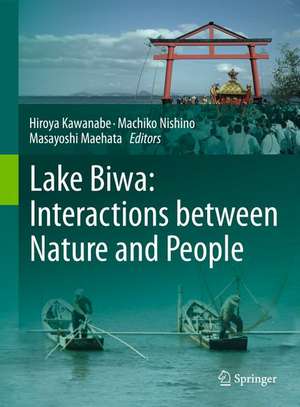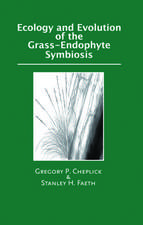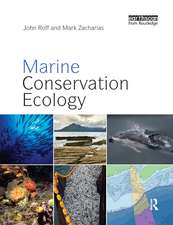Lake Biwa: Interactions between Nature and People
Editat de Hiroya Kawanabe, Machiko Nishino, Masayoshi Maehataen Limba Engleză Hardback – 25 mai 2012
Furthermore, various problems affecting the lake, especially recent environmental changes that occurred before and after Japan’s rapid economic growth of the 1950s and 60s, are reviewed, including water pollution, lakeshore development and the reclamation of attached lakes, alien and invasive species, and problems related to the recent warming of the climate.
Lastly, by analyzing data on these problems collected by the local government and residents of the lake basin, the book provides a comprehensive outlook on the future of Lake Biwa and people’s lifestyles. As such, it provides indispensable information for all people engaged in improving and conserving water regimes around the world, as well as people interested in the culture and history of Japan.
| Toate formatele și edițiile | Preț | Express |
|---|---|---|
| Paperback (2) | 1095.94 lei 38-44 zile | |
| SPRINGER NETHERLANDS – 23 aug 2016 | 1095.94 lei 38-44 zile | |
| Springer International Publishing – 26 aug 2021 | 1638.38 lei 38-44 zile | |
| Hardback (2) | 1114.85 lei 38-44 zile | |
| SPRINGER NETHERLANDS – 25 mai 2012 | 1114.85 lei 38-44 zile | |
| Springer International Publishing – 26 aug 2020 | 1679.03 lei 38-44 zile |
Preț: 1114.85 lei
Preț vechi: 1466.90 lei
-24% Nou
Puncte Express: 1672
Preț estimativ în valută:
213.35€ • 231.67$ • 179.22£
213.35€ • 231.67$ • 179.22£
Carte tipărită la comandă
Livrare economică 18-24 aprilie
Preluare comenzi: 021 569.72.76
Specificații
ISBN-13: 9789400717824
ISBN-10: 9400717822
Pagini: 600
Ilustrații: XXX, 744 p.
Dimensiuni: 195 x 260 x 35 mm
Greutate: 1.75 kg
Ediția:2012
Editura: SPRINGER NETHERLANDS
Colecția Springer
Locul publicării:Dordrecht, Netherlands
ISBN-10: 9400717822
Pagini: 600
Ilustrații: XXX, 744 p.
Dimensiuni: 195 x 260 x 35 mm
Greutate: 1.75 kg
Ediția:2012
Editura: SPRINGER NETHERLANDS
Colecția Springer
Locul publicării:Dordrecht, Netherlands
Public țintă
ResearchCuprins
Preface.-
Chapter 1: Geological history and transition of the biota of Lake Biwa.-
Chapter 2: Biodiversity of Lake Biwa.-
Chapter 3: Ecological changes in Lake Biwa.-
Chapter 4: History of the relationship between people and Lake Biwa.-
Chapter 5: The use of Lake Biwa and people's lifestyle.-
Chapter 6: Evolving history of Lake Biwa and the Yodo River Basin management.-
Chapter 7: Environmental conservation of Lake Biwa.-
Appendix 1.-
Appendix 2.-
Appendix 3.-
Appendix 4.-.
Chapter 1: Geological history and transition of the biota of Lake Biwa.-
Chapter 2: Biodiversity of Lake Biwa.-
Chapter 3: Ecological changes in Lake Biwa.-
Chapter 4: History of the relationship between people and Lake Biwa.-
Chapter 5: The use of Lake Biwa and people's lifestyle.-
Chapter 6: Evolving history of Lake Biwa and the Yodo River Basin management.-
Chapter 7: Environmental conservation of Lake Biwa.-
Appendix 1.-
Appendix 2.-
Appendix 3.-
Appendix 4.-.
Notă biografică
Hiroya Kawanabe is Professor Emeritus at Kyoto University and Curator Emeritus of the Lake Biwa Museum. He is the Founding Director of the Center for Ecological Research, past President of the International Society of Species in Ancient Lakes, the Ecological Society of Japan and the Japanese Society of Ecology and Civil Engineering. His research themes are community ecology and life-culture diversity.
Machiko Nishino is the Head of the Integrated Analysis Division at the Lake Biwa Environmental Research Institute. Her research themes are ecology of freshwater invertebrates and conservation ecology.
Masayoshi Maehata is a Professor at Kobe Gakuin University and Curator Emeritus of the Lake Biwa Museum. Research themes are fish ecology and conservation ecology.
Machiko Nishino is the Head of the Integrated Analysis Division at the Lake Biwa Environmental Research Institute. Her research themes are ecology of freshwater invertebrates and conservation ecology.
Masayoshi Maehata is a Professor at Kobe Gakuin University and Curator Emeritus of the Lake Biwa Museum. Research themes are fish ecology and conservation ecology.
Textul de pe ultima copertă
This book focuses on the long-term interactions between people and nature in and around Lake Biwa, one of the oldest lakes in the world. Accordingly, it not only covers the characteristics of the biota of this ancient lake, but also approaches it as a ‘cultural ancient lake.’
Furthermore, various problems affecting the lake, especially recent environmental changes that occurred before and after Japan’s rapid economic growth of the 1950s and 60s, are reviewed, including water pollution, lakeshore development and the reclamation of attached lakes, alien and invasive species, and problems related to the recent warming of the climate.
Lastly, by analyzing data on these problems collected by the local government and residents of the lake basin, the book provides a comprehensive outlook on the future of Lake Biwa and people’s lifestyles. As such, it provides indispensable information for all people engaged in improving and conserving water regimes around the world, as well as people interested in the culture and history of Japan.
Furthermore, various problems affecting the lake, especially recent environmental changes that occurred before and after Japan’s rapid economic growth of the 1950s and 60s, are reviewed, including water pollution, lakeshore development and the reclamation of attached lakes, alien and invasive species, and problems related to the recent warming of the climate.
Lastly, by analyzing data on these problems collected by the local government and residents of the lake basin, the book provides a comprehensive outlook on the future of Lake Biwa and people’s lifestyles. As such, it provides indispensable information for all people engaged in improving and conserving water regimes around the world, as well as people interested in the culture and history of Japan.
Caracteristici
First complete compilation of the interaction between humans and nature around Lake Biwa First complete compilation of Lake Biwa's changing environments and biota Describes all current problems and their solutions associated with Lake Biwa
















